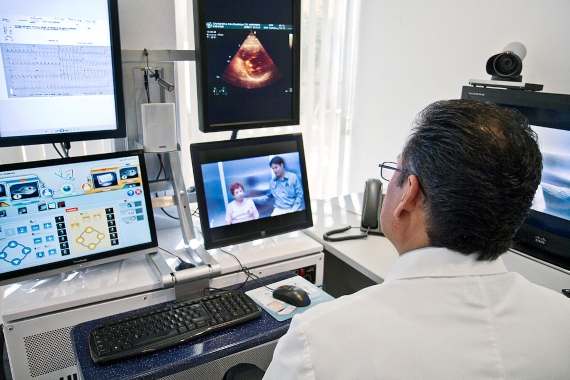Paris Fashion Week was once again held in virtual format this January, as it was in 2020 when the COVID-19 pandemic forced this and other major fashion events, normally social events of international renown, to resort solely to videos and online presentations. It is yet another example of how the SARS-CoV-2 coronavirus has transformed living into teleliving, an on-screen version of what used to be all our spheres of socialisation, from the intimate and private to the most multitudinous. But as the vaccination campaigns progress and we begin to dream of a much-hoped-for end to the pandemic, how much of this non-face-to-face living will last once the virus has been subdued, and how will it affect the organisation of our societies?
Gathering with friends and family via Zoom, FaceTime, Skype or Google Meet. Digital classrooms and telecommuting. Cancelled business trips. Online concerts. Sporting events without an audience. Remote conferences and congresses. Virtual visits to museums and exhibitions and even virtual tourism (although in this case it is more of a destination promotion tool than an alternative.) All these have become a sign of the times that we neither expected nor asked for, but which have been forced upon us by the urgency of the pandemic.

It is therefore not surprising that, among the most significant technologies to watch out for in 2021, a boom is expected in devices and applications designed to facilitate virtual interaction at all levels. Virtual reality (VR), or simulated digital environments, and augmented reality (AR), which adds information to the visualisation of the real world, have been part of our new consumer technologies for years, but until now they had only found a strong foothold in the entertainment sector, especially in gaming. Now, experts predict, we will see a surge in mixed reality (MR), which combines the real and virtual worlds, and in a broader sense, extended reality (XR), which encompasses all the applicable human-machine interactions, including those that may arise from future technologies not yet available.
Digital nomadism
This growth of virtuality will be present in almost all aspects of our lives, but undoubtedly the pandemic has accelerated the need for an abrupt and rapid transition in the academic world and the workplace. As far as telecommuting is concerned, in Spain a report from EAE Business School estimated that COVID-19 boosted the number of companies with staff working from home from 4% before the crisis to 88%. The expansion of telecommuting is also driving the phenomenon of so-called digital nomadism, especially young people without dependents who work remotely, traveling the world.
With this impetus brought on by the pandemic, more than a few experts predict that telecommuting is here to stay. According to Susan Hayter, technical advisor to the United Nations International Labour Organization, telework was already a trend, but the pandemic has meant that “this future has arrived sooner than anticipated.” “A few large companies in developed economies have already said that what has been a large and unplanned pilot – remote telecommuting – will become the standard way of organising work,” so that “employees need not commute to work, unless they choose to do so.”

For Hayter, “this may indeed be cause to celebrate, for people and the planet,” since reducing commuting will result in greater environmental sustainability. However, she also warns that in developed countries only 27% of employees can currently telecommute, and that this shift poses new challenges, such as the right to disconnect in order to separate work and leisure or the improvement of health and safety conditions in workplaces for those who cannot take advantage of this option, or who simply prefer to combine it with the classic model; according to a survey by the business communication platform Slack, 72% of professionals consulted prefer a hybrid workplace model.
In order to face the challenges and facilitate a greater implementation of post-COVID teleworking, the Organization for Economic Cooperation and Development (OECD) has asked governments to encourage investment “to maximise the gains for productivity and welfare inherent in the use of more widespread telework.” Meanwhile, large consulting firms such as McKinsey, Deloitte and PwC are working to promote this transformation of work, with attention paid to aspects such as productivity and cybersecurity to ensure its sustainability.
Cybersecurity and telehealth
In particular, cybersecurity is an aspect of telepresence that not only concerns companies, but also private users. At the onset of the pandemic, the video chat tool Zoom emerged as the top choice for virtual meetings worldwide; it grew from 10 million daily users in December 2019 to over 300 million in April 2020. This explosive growth led to the appearance of security flaws and cases of data theft to which the company reacted with updates, but which also forced users to adapt quickly and take extreme precautions in their online exchanges. It is clear that a future end to the pandemic will bring us back to having face-to-face with friends and family, but it also seems likely that video chat tools will increase contact with those who are far away.

Health care is another area that has seen enormous grown in its virtual versions because of the pandemic; for example, video consultations at West Virginia University’s (WVU) medical service increased by 8,000% from January to April 2020. Telehealth today includes options such as video consultation, remote monitoring of patients via devices, and communication and data management tools for both the patient and the health care professional. It is likely that the fear of coronavirus has driven many users to seek telehealth, but also that this is a trend here to stay, especially as the deployment of AR and VR increases. According to WVU professor Jennifer Mallow, a telehealth expert, “not all health care can be done by telehealth, but a lot can, and research shows that in many cases it’s just as good as in-person care.”
New cultural explorations
Culture and entertainment have also exploited the potential of virtual platforms. Instead of being restricted only to broadcasting recorded events or live streaming them (an option chosen for numerous concerts or presentations of musical works), interactive online productions have also been mounted with audience participation, inventing new immersive and personalised experiences that are only possible through technology. While some experts believe that digital theatre is only a temporary fix, a poor substitute that will disappear after the pandemic, others predict that these new explorations, “borne out of necessity, are an opportunity to rethink theatre” and “should inform theatre’s future,” wrote Kelsey Jacobson, professor of drama at Queen’s University in Ontario, in The Conversation.
Ultimately, as Indian biologist and entrepreneur Kiran Mazumdar-Shaw, president of the multinational biotech company Biocon, reflected in her blog, the new normal after this pandemic is likely to be different from the one we knew before. We will once again sit face-to-face, but perhaps business trips, in-person business meetings, visits to the bank or even handshakes “will be a thing of the past.” “COVID-19 will reboot the world into virtual reality,” she wrote. But it’s up to us to avoid a dystopian future: “Ultimately, the greatest lesson that COVID-19 can teach humanity is that we are all in this together, that what affects a single person anywhere affects everyone everywhere, that as Homo sapiens we need to think and act unitedly.”
Comments on this publication